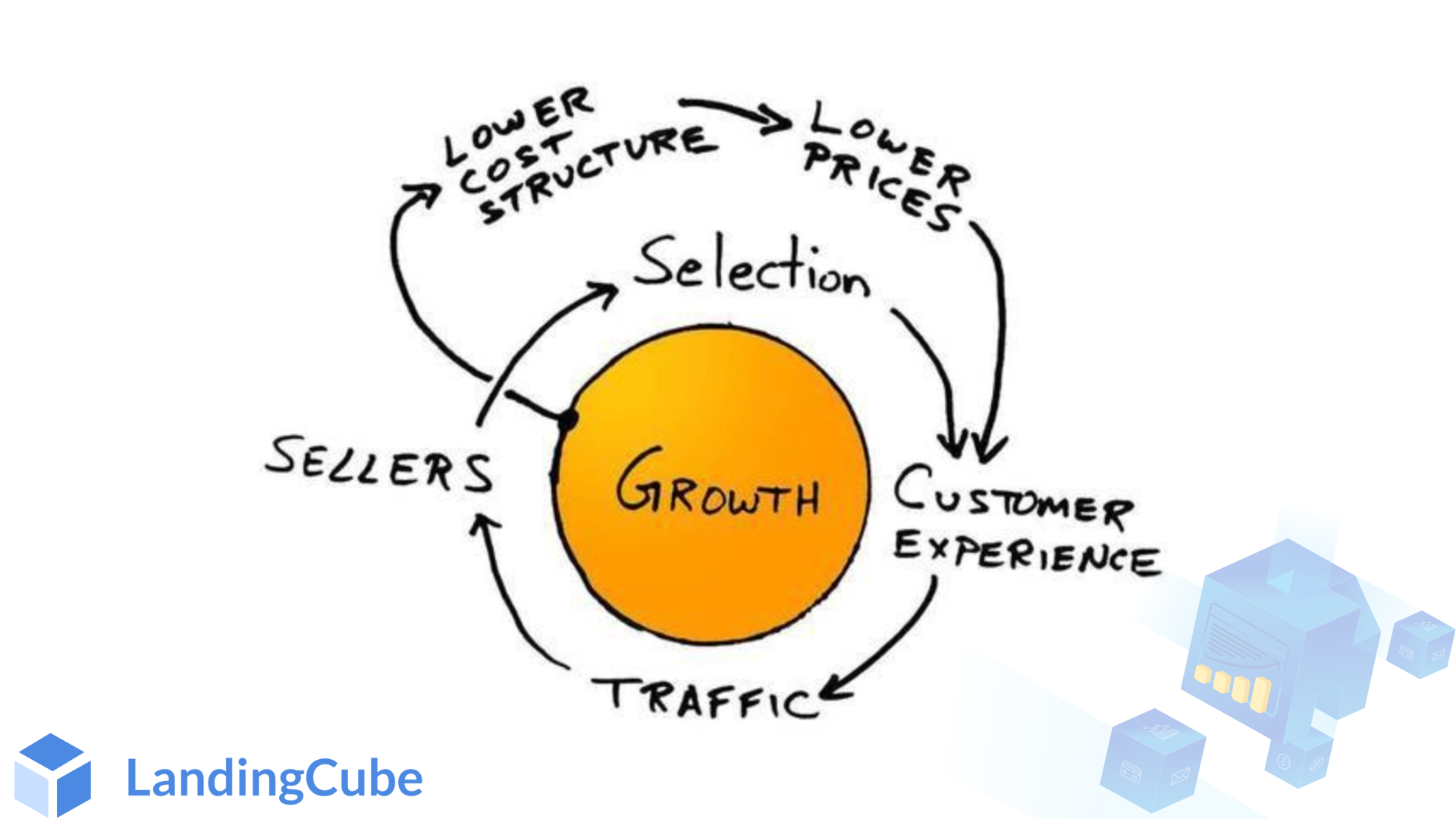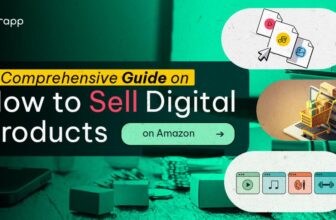
The Amazon flywheel business model is one of the most well-known models in modern business history.
It shouldn’t be any surprise, as Amazon is one of the most significant businesses we’ve seen, and certainly the biggest in the world today. Businesses like these don’t grow by accident.
We can learn a lot from the Amazon flywheel model, even if you’re a small brand without grand designs of becoming a trillion-dollar company. Read on to learn what it is, and how to apply it for your business.
What is the Amazon Flywheel Model?
The Amazon flywheel is a business model that essentially changed history, and forms the backbone for how Amazon grew into a company worth over a trillion dollars.
It started out as a sketch on a napkin, written by Jeff Bezos in a meeting with Jim Collins in 2000. It plots out a plan for how Amazon was going to grow, using a few core principles that would feed off one another, creating a self-perpetuating flywheel.

The model has been discussed ad nauseam in the years since, and is still a core part of the business today.
You can check out a video of it being broken down by Jeff Wilke, former Amazon Consumer CEO, here:
It’s also been coined the “Amazon Virtuous Cycle”. And its effectiveness is clear for anyone to see.
How the Amazon Flywheel Works
The Amazon flywheel is simple, and fairly self-explanatory from the napkin sketch.
Here’s a breakdown of each of the steps, and how they feed into each other and ultimately drive growth.
- The key focus is the Customer Experience. That’s the central point that the flywheel is built around.
- A positive customer experience leads to more customers, and a steady flow of Traffic.
- Traffic leads to a high demand for Sellers on the Amazon platform.
- More third-party sellers means a wide and diverse Selection for Amazon shoppers to choose from.
- That wide selection plays into the great Customer Experience, which keeps the flywheel moving.
Then there’s another offshoot that helps the flywheel keep moving:
- Amazon focused on building a business with a Lower Cost Structure.
- That means they can remain profitable while offering Lower Prices, which plays again into a great Customer Experience, perpetuating the rest of the flywheel.
Its simplicity shows you don’t need anything incredibly complex to build a successful business. All you need is a few simple principles, executed well.
The Flywheel’s Effect on Amazon’s Growth
It doesn’t take much analysis to see that the Amazon flywheel strategy has been successful for Amazon. Just look at where they are now. Amazon the company is more recognizable than the Amazon in South America (it’s a rainforest too, in case you didn’t know).
But Amazon’s trajectory of growth shows just how effective the flywheel has been, and how the flywheel business model has been the key driver for the company to get as big as it is today.
In 2000-2001, when the famous flywheel napkin meeting took place, Amazon was far from a big name. The business was pretty stagnant, actually.
Since they established the flywheel and their identify of customer obsession, things really picked up. It took a few years to kick the flywheel into motion, but once it did, Amazon’s growth began to compound, and compound, to eventually become a company doing hundreds of billions of dollars in sales every year.


This trajectory is the crux of how a flywheel business model works. It’s not something that provides quick wins. A flywheel takes effort, work and investment to set up, and more to keep it moving in its early stages. But in time, when the flywheel starts moving, it drives itself and offers an incredible vehicle for growth.
Is Amazon’s Flywheel Strategy Applicable for Small Sellers?
The Amazon flywheel model has obviously been great for Jeff Bezos and Amazon. But what about the smaller third-party sellers out there? Those who don’t have any grand designs of becoming a billion or trillion-dollar company?
The great thing about the flywheel business model is that it works for all kinds of business. The principles are very simple, and while it might not work the exact same for you as it does for Amazon or another marketplace-type business, you can still take some pointers away to use on your own.
How Third-Party Sellers Can Implement a Flywheel Business Model of Their Own
Now for the practical side. How can you take away what we’ve learned from Amazon’s flywheel business model, and implement the same thing for your own business, as a third-party seller?
Obviously you need to tweak it a bit, as you’re not trying to follow the exact same blueprint. Your business is different to Jeff Bezos’ business in 2000, you have different goals, different challenges.
Here are some important principles and tips brands should take away from the Amazon flywheel.
The Customer Comes First
I believe this is the core of any business.
Without customers, you have no business. So they should be the most important part of your business. Everything should come back to the customer experience, and how you can produce happy customers.
This is particularly important for Amazon businesses, because it’s not just your customers you’re trying to please. They’re Amazon’s customers, first and foremost.
We’ve already seen that the customer experience is key for Amazon’s business model. So they’re going to favor sellers who also push this.
For any decision you make, bring it back to the customer. How does this affect the customer experience? Does it elevate it, or does it risk damaging the customer experience? For any 50-50 calls you have to make, think of what it means for the customer, and use that as the tiebreaker for any situation where you’re not sure what to do.
Maintain Good Amazon SEO
SEO is a key part of building a flywheel for your store, and indeed works as a flywheel on its own.
When you get your product to rank, you make sales. Making sales benefits your rankings, and the two continue working off of each other.
That’s why Amazon SEO has to be your core focus as an Amazon seller. Getting this right makes it so much easier to build a sustainable store, and make sales without having to grind or pay for every customer.
Run an Effective Product Launch
An effective Amazon flywheel starts with your product launch. This is when you gain momentum that kicks the flywheel into motion.
Our guide has some tips on running an effective Amazon product launch, most of which can be thought of through the lens of the flywheel you’re trying to create.
You need strong SEO fundamentals, such as a good base of keywords to target and a high-quality product, which will form the structure of your flywheel. Then it’s the initial sales you drive that starts it moving. If you do everything else, the Amazon cycle will start working and sending you sales automatically.
Set Up Evergreen PPC & External Traffic Campaigns
Like Amazon, your flywheel will not lead to explosive growth straight away. Flywheels gather speed slowly, and need nurturing before you get to see the benefits of long-term, compounding growth.
You can do things during the early stages of your flywheel strategy to keep it moving. PPC ads are one – they help give a steady increase in sales and keep momentum going.
Also, evergreen external traffic campaigns are a great supplement for organic sales. Google Adwords for example, you can set up and run on autopilot, delivering a constant flow of sales, along with the positive ranking effect of external traffic.
Learn more here about running Google Ads for Amazon products. And for help running profitable PPC campaigns, check out SellerMetrics, who have the industry-leading PPC management software, as well as a managed PPC service that can help you out.
Reviews are another key part of the flywheel process. The more positive reviews you get, the better your product looks to future customers, and the more opportunities you have to get reviews.
Reviews are also a sign that you’re providing a great customer experience, again one of the most important parts of the Amazon flywheel model.





